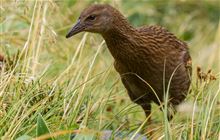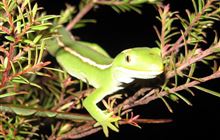Wayward weka found in Manaia
Archived content: This media release was accurate on the date of publication.
Introduction
Manaia man Pete Andreoli did a double take when he saw a weka wandering around a back yard in the little South Taranaki township.Date: 24 January 2023
Although the large brown flightless birds known for their feisty and curious personalities are common in many alpine areas in the South Island, they’ve not been sighted in Taranaki for decades – and this bird’s arrival sees DOC calling on the public for sightings of other weka in the district.
“My son saw this bird in his back yard and sent a video,” says Pete. “I thought ‘what the hell’s a weka doing in Manaia?’.”
Realising it was a bird out of place, he managed to trap the wayward weka using a trout net on a long pole.
“It took a bit of catching as it had some good side steps.”
He popped the bird it into his vegetable shade house for safekeeping.
A quick call to the 0800 DOC HOT (0800 362 468) hotline resulted in some minor confusion. The ranger answering the call was from the South Island, where weka are relatively common – and Pete was told to release the bird in the forest.
Pete got hold of the local DOC office staff to determine the best course of action for the weka.
The bird is now being cared for off display at Brooklands Zoo where DNA tests will hopefully give DOC a further piece in the puzzle of where the bird originated from. Once the DNA tests come in a decision will be made on where the weka will be rehomed.
The bird’s sex is not known.
“Because of its scavenging habit, the weka occupies a problematic conservation niche,” says DOC Taranaki Senior Ranger Biodiversity Cameron Hunt.
“They can have predatory impacts on other fauna, especially burrow-nesting seabirds, ground nesting birds, reptiles, and large invertebrates.
“If weka were to get on Taranaki Maunga they pose a real risk to the native wildlife while the ecosystems and populations are still in such a recovery phase.”
Photos seen by DOC show the weka may have had a mate – and with another weka possibly on the loose in Manaia, DOC is asking for reports of the bird.
Although it’s unknown how the birds got to Manaia, it’s possible the weka were released illegally says Cameron.
“Weka are flightless and their closest known natural habitat in the North Island is near Opotiki or up by the Hauraki Gulf. In the south they are in Marlborough. It’s entirely unusual for one to turn up in Manaia.”
To catch, hold or release wildlife species you must have permission from DOC. Holding or releasing native wildlife can result in fines and or prosecution.
Background information
Records show weka were in Taranaki in 1918 but reported to be gone from the region by 1938. An attempt at reintroducing weka to Mt Taranaki in the 1970s was deemed unsuccessful, with one weka turning up at Port Taranaki and no other confirmed sightings. Unconfirmed sightings of weka were reported on the south side of Mt Taranaki in the early 2000s.
Weka recovery plan 1999-2009 (PDF, 755K)
Contact
For media enquiries contact:
Email: media@doc.govt.nz


